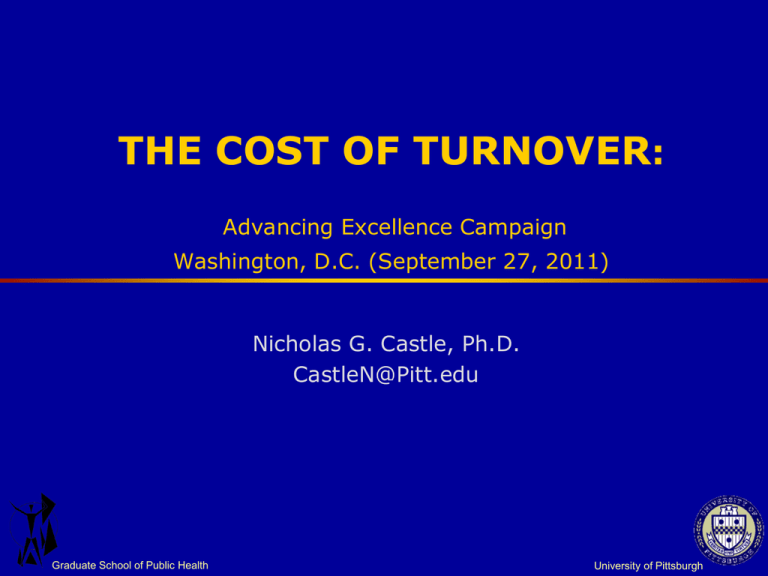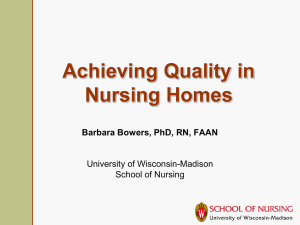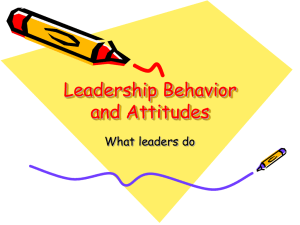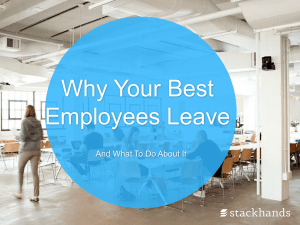The Cost of Turnover - Kentucky Association of Health Care Facilities
advertisement

THE COST OF TURNOVER: Advancing Excellence Campaign Washington, D.C. (September 27, 2011) Nicholas G. Castle, Ph.D. CastleN@Pitt.edu Graduate School of Public Health University of Pittsburgh INTRODUCTION: Introduction From ivory tower (in PA) Tell you what you already know! Resident-to-resident abuse Patient Safety Culture Agency staff use Worker injuries Quality of care Deficiency citations Leadership TURNOVER (TODAY) Graduate School of Public Health University of Pittsburgh INTRODUCTION: Introduction / Conclusion Bottom line Need less turnover Turnover influences quality (Men’s Health: Research stating the obvious!) More “refined” message(s) Others need to understand importance of turnover Many costs associated with turnover Graduate School of Public Health University of Pittsburgh INTRODUCTION: What to expect! Research (what we know about turnover) Format (information) No formula No prescription Some advice AND Thank You! >20,000 surveys (10 years) Provide Some Feedback Graduate School of Public Health University of Pittsburgh INTRODUCTION: Research Sponsor The Commonwealth Fund Staff Assist http://www.crhc.pitt.edu/StaffAssist/ o CAHPS Survey (Satisfaction) o U. Pitt Research Network Graduate School of Public Health University of Pittsburgh TOP MANAGEMENT TURNOVER: How Much Turnover? (Study 1): TOP MANAGEMENT TURNOVER Administrators, average turnover rate of 43% per year. Directors of Nursing, average turnover rate of 39% per year. In most facilities one member of top management leaves every year. Some facilities had 6 NHAs or 6 DONs in one year. Primary data from surveys of approx 3,000 top managers (2005, 2007, 2009) Graduate School of Public Health University of Pittsburgh TOP MANAGEMENT TURNOVER: How Much Turnover? (Study 1): TOP MANAGEMENT TURNOVER More Details NHA / DON probability of remaining in same position for 3 years < 33% Administrators, average turnover rate of 43% per year. Facilities with stable (>2 year tenure) NHA and DON = 23%. Facilities with “excess” turnover (>4 NHA and/or DON) = 19% Graduate School of Public Health University of Pittsburgh TOP MANAGEMENT TURNOVER: Where do you go? Cohort of 748 NHAs Time 0 Retired 23 (3%) Retired 28 (4%) Retired 33 (4%) Retired 37 (5%) OTHER NH 86 NHAs (12%) OTHER NH 91 NHAs (12%) OTHER NH 106 NHAs (14%) OTHER NH 90 NHAs (12%) SAME FACILITY 618 NHAs (82%) SAME FACILITY 502 NHAs (67%) SAME FACILITY 357 NHAs (48%) SAME FACILITY 272 NHAs (36%) NOT WORKING IN LTC 21 NHAs (3%) NOT WORKING IN LTC 27 NHAs (3.6%) NOT WORKING IN LTC 23 NHAs (3%) NOT WORKING IN LTC 20 NHAs (3%) 6 months 1 year 1.5 years 2 years Setting: 6 states, randomly chosen participants TOP MANAGEMENT TURNOVER: Where do you go? Percent Administrator Turnover (Cohort, N=748) 90 80 70 60 50 40 30 20 10 0 82 67 48 36 6 12 18 24 33 36 Time (months) 30 42 28 48 26 54 TOP MANAGEMENT TURNOVER: Where do you go? Some questions of importance: Retire Reasons Other nursing homes Why Other LTC facilities Same facility Why Not working in LTC Why Good / bad Graduate School of Public Health University of Pittsburgh TOP MANAGEMENT TURNOVER: Why do you leave? Able to answer some important questions DEFICIENCY CITATIONS? Some association (fired or quit?) Stronger over time (performance matters) Not so much with NHC QMs DON Less able to work in acute care? Not true, frequent moves Influence of age Graduate School of Public Health University of Pittsburgh TOP MANAGEMENT TURNOVER: Why do you leave? Examine: Levels of job satisfaction SAME FACILITY Most satisfied with rewards, work skills, coworkers, work load Least satisfied with work demands OTHER NURSING HOME Most satisfied with rewards and work skills Least satisfied with work demands, coworkers, and work load NOT WORKING IN LTC Most satisfied with rewards Least satisfied with work skills, work demands, coworkers, and work load Graduate School of Public Health University of Pittsburgh TOP MANAGEMENT TURNOVER: What Helps? (Study 2): THE EFFECTS OF TOP MANAGEMENT PROFESSIONAL DEVELOPMENT ON ADMINISTRATOR TURNOVER Examines characteristics associated with professional development of the top management team and administrator turnover. Primary data from 406 nursing homes. Professional development lowers turnover rate (assumes lower top management turnover is important). Graduate School of Public Health University of Pittsburgh State Alabama Alaska Arizona Arkansas California Colorado Connecticut Delaware Florida Georgia Hawaii Idaho Illinois Indiana Iowa Kansas Kentucky Louisiana Maine Website http://www.alboenha.state.al.us/ http://www.commerce.state.ak.us/occ/pub/nha4020.pdf Minimum Degree Associates Baccalaureate-HC or Business Additional Requirements Supervisor Experience; AIT Program Experience http://www.aznciaboard.us/New%20rules%20effective%204-5-08.pdf https://www.medicaid.state.ar.us/Download/general/units/oltc/regs/nhadmin.pdf Associates Associates current RN; AIT program Coresework; internship or experience http://www.cdph.ca.gov/pubsforms/forms/CtrldForms/cdph526.pdf (RN) Work experience; current RN; AIT Associates, HC related field http://www.colorado.gov/oed/industry-license/300IndDetail.html Baccalaureate http://www.ct.gov/dph/lib/dph/practitioner_licensing_and_investigations/applications/pdf/nha2000.pdf Supervisor Experience Residency training Associates http://regulations.delaware.gov/AdminCode/title24/5200.shtml Experience or AIT AIT Program or Experience Baccalaureate http://www.leg.state.fl.us/statutes/index.cfm?App_mode=Display_Statute&Search_String=&URL=0400-0499/0468/Sections/0468.1695.html Experience; AIT H.S. Diploma http://rules.sos.state.ga.us/docs/393/3/02.pdf Experience or AIT Baccalaureate http://hawaii.gov/dcca/pvl/programs/nursinghome/application_publications Experience; AIT H.S. Diploma https://secure.ibol.idaho.gov/IBOL/BoardAdditional.aspx?Bureau=NHA&BureauLinkID=100 http://lmi.ides.state.il.us/licensure/n/239.htm http://www.in.gov/pla/2813.htm http://www.legis.state.ia.us/aspx/ACODOCS/DOCS/645.141.pdf http://www.kdheks.gov/hoc/regs/28-38.pdf 60 semester hours Associates, HC Baccalaureate Baccalaureate Experience AIT Coursework; Practicum Practicum http://www.lrc.ky.gov/KRS/216A00/080.PDF http://www.labenfa.com/ http://www.maine.gov/sos/cec/rules/02/chaps02.htm#371 Baccalaureate 60 semester hours Baccalaureate Experience or internship Experience Cert in LTC or credits in management; AIT State Alabama Alaska Arizona Arkansas California Colorado Connecticut Delaware District of Columbia Florida Georgia Renewal Annual Biennial Biennial Annual Annual Annual Biennial Biennial Biennial Biennial Biennial CEUs 24 hours 50 hours 20 CEUs 40 hours None 40 hours 48 hours 40 hours 40 hours 40 hours Detail Only 6 hours can be NAB/NCERS approved self-study Signed statement June 30th even years; board approved 10 hours in aging or patient care July 31 odd years June 30th even years Dec 31 odd years; 6 hours in ethics or resident rights Cost 125 300 100 190 51 200 mailed to individuals 250 125 State Arizona Arkansas Hours/etc Topics knowledge of proper needs to be served by nursing care institutions; background in the laws and rules governing the operation of nursings care institutions and the protection of the interests of the patients in nursing care insitutions; training in elements of good health care facililties administration Substitutes 15 semester hours; 3 hours per topic Accounting College or Vocational courses Management Work exp (6 weeks = 1 credit hour) CLEP CEU (10 contact hours = 1 credit hour Personnel Writing Connecticut LTCA study Resident Care General Admin and Management Financial Management laws and Regulations Personnel management and labor Relations Patient Care and Services Planning and Delivery Systems Gerontology Impact of Education of Nursing Home Administrators on Quality Jessica Furnier & Nicholas Castle Department of Health Policy and Management, Graduate School of Public Health, University of Pittsburgh. Objective Results Discussion To determine the relationship between education level of Nursing Home Administrators (NHAs) and quality of care. A total of 4,003 NHAs returned the demographics and job characteristics survey, giving a response rate of 67%. The response rate varied little across the states, and in general, most items on the questionnaire were answered. Four Quality Measures were examined in this investigation (restraint use, inadequate pain management, and two measures for pressure sores). Prior research identified these Quality Measures to be sensitive to top management characteristics. NHA AGE NHA TENURE NHA EDUCATION High School, 4% <30 years, 16% Associat es, 9% Ot her, 27% <1year, 24% >5 years, 32% Introduction As noted in the Institute of Medicine’s 2001 report, nursing home quality is poor. Research indicates an association between organizational performance and characteristics of top management in a variety of industries, including healthcare. The influence of top managers of nursing homes (i.e., NHAs), has been demonstrated by recent research linking high NHA turnover to deficiency citations and poor resident quality of care (Castle, 2005). >51years, 40% 30-40 years, 22% Bachelors, 55% 1-2 years, 19% Mast ers, 30% 2-5 years, 25% 22% Table 1 shows increased education is positively associated with better quality of care. Table 1: Results Examining the Influence of Education on Nursing Home Quality Indicators (1) (2) Percent Physical Restraint Use (LSR)^ Percent With Moderate to Severe Pain (LSR)^ 28.5*** (1.44) 45.1*** (1.25) 47.7 (1.31) 47.3*** (2.01) 27.3*** (1.53) 39.9*** (1.33) 42.5*** (1.39) 42.7*** (2.14) Variables Research in other industries has shown that education is positively associated with organizational commitment. Higher levels of education have also been associated with increased performance (Chevalier, 2004). We hypothesize that a higher educational background of NHAs will be associated with better quality of care. NHA Education Associates Degree (vs. High School Diploma) Bachelors Degree (vs. High School Diploma) Masters Degree (vs. High School Diploma) > Masters Degree (vs. High School Diploma) Methods and Materials Educational data: Collected via mail survey with follow-up reminder postcards. (6,000 mailed; 4,003 returned) Additional data collected: gender, age, race, and tenure. 41-50 years, (3) (4) Percent Low- Percent High-Risk Risk Residents Residents With With Pressure Pressure Sores Sores (LSR)^ (LSR)^ 14.5*** (2.1) 27.2*** (1.81) 30.5*** (1.88) 28.9*** (2.89) 10.8*** (2.25) 23.8*** (1.95) 27.8*** (2.03) 25.9*** (3.1) *p < .05; **p < .01; ***p < .001. NHA = Nursing Home Administrator; FTE = full-time equivalent, ADL = activities of daily living, RNs = Registered Nurses, LPNs = Licensed Practical Nurses; LSR = long-stay resident ^ Definitions can be found in Abt (2004). Quality data: Obtained from Nursing Home Compare Measures included: restraint use, inadequate pain management, and two measures for pressure ulcers. NOTE: Coefficients of interest are presented. The regression models also include as controls – Top Management Factors (Tenure, Turnover (past 3 years), age, member of a professional association) Staffing Factors (Nurse aide staffing (FTEs per resident), LPN staffing (FTEs per resident), RN staffing (FTEs per resident)) Resident Factors (Resident case-mix (ADL score), Psychiatric condition, Mental retardation, Dementia Organizational Factors (Medicaid resident occupancy, Size (number of beds), For-profit ownership, Chain member, Occupancy rate) External Factors (Medicaid reimbursement rate, Competition (Herfindahl Index), Elderly in county (per 1000 population), Per capita income ($)) Analysis: Linear regression analyses used to examine the association of education with quality measures. References Abt Associates Inc (2004). National Nursing Home Quality Measures: User’s Manual. Cambridge, MA: Abt Associates. Retrieved August 25, 2010 http://www.cms.hhs.gov/NursingHomeQualityInits/35_NHQIArchives.asp#TopOfPage Chevalier, A., Harmon, C., Walker , I. and Y. Zhu, 2004, “Does Education Raise Productivity, or just Reflect It?”, Economic Journal, Vol. 114, F499-517. Castle, N.G. (2005). Turnover begets turnover. The Gerontologist, 45, 186-195. We find ALL four of these measures to be positively associated with NHA education. As the average age of the elderly increases, the complexity of care provided in nursing homes will rise, and additional educational preparation may prove to be critical to meet these ever increasing demands. Public Health & Policy Impact 3.5 million elders per year receive care in nursing homes. Much of this care is sub-standard and can cause harm (Almost all facilities received citations in 2008). Each state has minimum requirements for licensure (which includes education levels). States have extensive latitude in their licensure requirements. Increasing minimum education levels may improve management and in turn, improve quality. Significantly, the point estimates show that moving NHA education levels from a High School Diploma to a Bachelors degree would be associated with: 45% reduction in Physical Restraint Use. 40% reduction in residents with Moderate to Severe Pain. 27% reduction in incidence of Pressure Sores in LowRisk Residents. 24% reduction in incidence of Pressure Sores in HighRisk Residents. Future Directions Examine the impact of: Minimum state training requirements on quality NHA and Director of Nursing Experience on quality Continuing education on quality Variables (1) Physical Restraint Use NHA Education Associates Degree (vs. High School Diploma) Bachelors Degree (vs. High School Diploma) Masters Degree (vs. High School Diploma) > Masters Degree (vs. High School Diploma) STATE Licensure Education Score (1,2,3) Training Score (0-100) *p < .05; **p < .01; ***p < .001. (2) (3) (4) Inadequate Low-Risk High-Risk Pain Residents With Residents With Management Pressure Sores Pressure Sores (5) Residents With Catheters 27.9*** (1.44) 43.6*** (1.25) 43.5*** (1.31) 47.2*** (2.01) 27.8*** (1.53) 39.3*** (1.33) 41.4*** (1.39) 42.9*** (2.14) 14.5*** (2.1) 26.4*** (1.81) 29.3*** (1.88) 29.3*** (2.89) 11.6*** (2.25) 23.9*** (1.95) 27.3*** (2.03) 26.6*** (3.1) 7.8*** (2.00) 19.9*** (1.74) 23.3*** (1.82) 23.2*** (2.79) 3.8*** (0.43) 0.11*** (0.02) 3.4*** (0.43) 0.12** (0.03) 3.3*** (0.54) 0.05 (0.03) 3.4*** (0.57) 0.04 (0.03) 3.9*** (0.50) 0.03 (0.03) TOP MANAGEMENT TURNOVER: So What? (Study 3): ADMINISTRATOR TURNOVER AND QUALITY OF CARE IN NURSING HOMES Study Administrator turnover is associated with a higher than average proportion of residents who were catheterized had pressure ulcers were given psychoactive drugs and with a higher than average number of quality-ofcare deficiencies. Repeated with DON Similar findings (different QMs) Graduate School of Public Health University of Pittsburgh QUALITY Turnover 390 370 350 330 310 290 270 250 230 210 190 170 150 130 110 90 70 50 30 10 TURNOVER Quality 100 90 80 70 60 50 40 30 20 10 0 QUALITY Turnover 390 370 350 330 310 290 270 250 230 210 190 170 150 130 110 90 70 50 30 10 TURNOVER Quality 100 90 80 70 60 50 40 30 20 10 0 QUALITY Turnover 390 370 350 330 310 290 270 250 230 210 190 170 150 130 110 90 70 50 30 10 Quality TURNOVER 100 90 80 70 60 50 40 30 20 10 0 TOP MANAGEMENT TURNOVER: So What? (Study 4): TURNOVER BEGETS TURNOVER Association between turnover of nursing home administrators and staff turnover. 419 nursing facilities and the 1999 On-line Survey, Certification, and Reporting System (OSCAR) 10% increase in top management turnover 21% increased turnover of Nurse Aides 30% increased LPN and RN turnover Confirms interviews with nurse aides “If management does not want to work here, why should I?” Graduate School of Public Health University of Pittsburgh The Quality Porcupine Parsimony vs. Completeness Data Sources QUALITY Quality FACILITY CONTEXT AND MARKET CONTEXT (e.g., bed size, ownership, chain membership, occupancy, Medicaid occupancy, top management) (e.g., competition, unemployment) ++ Staffing levels +++ Staff Stability ++ Professional Staff Mix --- Agency staff +++ Consistent resident assignment Staffing interactions^ Staffing nonlinearities^^ 0 Staffing levels 0 Staff Stability +++ Professional Staff Mix --- Agency staff +++ Consistent resident assignment Staffing interactions^ Staffing nonlinearities^^ CONSISTENCY COORDINATION Resident *Acuity *Demogra CARE PROCESSES QUANTITY OF CARE +++ Staffing levels 0 Staff Stability 0 Professional Staff Mix ++ Agency staff +++ Consistent resident assignment Staffing interactions^ Staffing nonlinearities^^ Resident Outcomes (Quality of Care) Top Management CARE PRACTICES + Staffing levels ++ Staff Stability +++ Professional Staff Mix Agency staff +++ Consistent resident assignment Staffing interactions^ Staffing nonlinearities^^ FACILITY AND MARKET CONTEXT + = hypothesized positive influence on care processes (with increasingly more +’s indicating a stronger positive influence); 0 = no hypothesized influence on care processes; – = Graduate of Public Health hypothesized School negative influence on care processes (with increasingly more –’s indicating a stronger negative influence). University of Pittsburgh STAFF TURNOVER: High levels of staff turnover in nursing homes? Nurse Aides = 71% Licensed Practical Nurses = 49% Registered Nurses = 50% Source: Decker at al. (2003) Graduate School of Public Health University of Pittsburgh STAFF TURNOVER: So What? GAO (2001): turnover among nurse aides working in nursing homes is: 13-18% percent higher than the overall labor force 20% higher than other service workers. 100,000 FTE vacancies at nursing homes ½ this post recession? Does vary by state Graduate School of Public Health University of Pittsburgh State AL AR AZ CA CO CT DE FL GA IA ID IL IN KS KY LA MA MD ME MI MN MO MS MT NC ND NE NH Number of Facilities in Sample 119 124 62 548 107 170 26 455 192 242 29 446 213 176 168 121 228 122 60 217 189 264 73 30 214 36 111 45 NA 1 Turnover 82% 121% 93% 61% 57% 43% 60% 66% 78% 55% 62% 58% 74% 87% 92% 95% 47% 49% 41% 53% 81% 91% 60% 58% 68% 38% 36% 49% LPN 1 RN 1 DON 2 NHA 2 Turnover Turnover Turnover Turnover 44% 66% 72% 42% 40% 33% 27% 57% 55% 32% 47% 40% 57% 59% 53% 43% 45% 38% 30% 32% 26% 53% 56% 44% 50% 22% 24% 34% 50% 51% 69% 45% 40% 39% 37% 51% 45% 35% 54% 43% 57% 55% 59% 50% 43% 40% 32% 36% 28% 53% 71% 42% 45% 25% 21% 34% 55% 63% 67% 51% 44% 35% 21% 53% 56% 32% 37% 42% 50% 46% 53% 28% 36% 29% 23% 26% 21% 52% 55% 37% 33% 24% 25% 28% 47% 55% 63% 58% 40% 37% 27% 50% 57% 39% 39% 40% 53% 43% 46% 36% 33% 40% 30% 28% 33% 48% 44% 47% 38% 32% 29% 31% NA Vacancy 3 Rate LPN Vacancy 3 Rate RN Vacancy 3 Rate 10% 8% 7% 10% 8% 9% 12% 12% 10% 7% 8% 8% 11% 10% 8% 10% 9% 12% 9% 11% 10% 9% 12% 13% 9% 10% 11% 12% 10% 11% 11% 15% 12% 11% 14% 12% 12% 10% 9% 8% 12% 7% 7% 9% 14% 11% 7% 11% 10% 14% 15% 15% 10% 9% 9% 13% 9% 12% 13% 14% 11% 14% 15% 12% 14% 9% 10% 10% 15% 9% 8% 8% 15% 12% 8% 10% 9% 13% 14% 16% 10% 6% 8% 14% NOTE: data from 8,023 nursing homes collected in 2004 (Castle, 2005) State NJ NM NV NY OH OK OR PA RI SC SD TN TX UT VA VT WA WI WV WY SUMMARY Number of Facilities in Sample 200 34 12 351 520 164 82 366 51 90 51 175 547 38 103 18 142 220 60 12 8023 NA 1 Turnover 49% 72% 66% 43% 71% 75% 61% 42% 63% 66% 47% 80% 82% 81% 66% 62% 60% 43% 55% 50% 64% LPN 1 RN 1 DON 2 NHA 2 Turnover Turnover Turnover Turnover 36% 57% 67% 35% 41% 59% 39% 35% 36% 46% 24% 50% 52% 46% 51% 24% 39% 27% 31% 37% 43% 42% 62% 66% 41% 50% 52% 46% 37% 53% 43% 21% 51% 54% 61% 49% 50% 37% 30% 58% 32% 46% 31% 46% 29% 37% 40% 57% 34% 30% 23% 31% 36% 41% 62% 48% 54% 24% 44% 35% 32% 36% 39% 35% 45% 32% 46% 41% 54% 39% 36% 32% 40% 42% 40% 41% 43% 57% 37% 32% 38% 39% 44% 41% NA Vacancy 3 Rate LPN Vacancy 3 Rate RN Vacancy 3 Rate 14% 10% 12% 12% 12% 13% 11% 13% 10% 10% 9% 11% 11% 11% 7% 8% 7% 9% 11% 8% 10% 15% 17% 13% 11% 10% 13% 10% 11% 11% 5% 6% 8% 8% 9% 10% 12% 14% 10% 12% 8% 11% 16% 16% 15% 12% 13% 10% 9% 12% 13% 9% 7% 9% 14% 12% 11% 12% 13% 11% 14% 9% 12% NOTE: data from 8,023 nursing homes collected in 2004 (Castle, 2005) STAFF TURNOVER: So What? Data used in this investigation came from surveys of nursing home administrators (N=6,005), Nursing Home Compare; Online System for Certification and Administrative Reporting data, and, the Area Resource File. From the 18 turnover variables of interest (i.e., 6 quality measures and NA, LPN, and RN turnover) 11 coefficients were statistically significant. Graduate School of Public Health University of Pittsburgh STAFF TURNOVER: Figure 1: Hypothesized Quality-Turnover Relationship Quality (higher value = lower quality) 140 120 100 80 60 40 20 0 0 5 10 15 20 25 30 35 40 45 50 55 60 65 70 75 80 85 90 95 100 Turnover (percent) Graduate School of Public Health University of Pittsburgh Long Stay Quality Factor and Nurse Aide Turnover and Agency Use Long Stay Quality Factor 0.6 0.4 0.2 0 -0.2 -0.4 -0.6 0 10 20 30 40 50 Percentage Agency Use quality at low na turn quality at mean na turn quality at high na turn Long Stay Quality Factor and Registered Nurse Turnover and Agency Use Long Stay Quality Factor 0.6 0.4 0.2 0 -0.2 -0.4 -0.6 0 5 10 15 20 25 30 Percentage Agency Use quality at low rn turn quality at mean rn turn quality at high rn turn STAFF TURNOVER (2): Causal Analysis? Registered Nurses, Licensed Practical Nurses, and Nurse Aides were measured quarterly from 2003 through 2007, and come from 3,939 facilities. Generalized method of moments (GMM) estimation was used to examine the effects of a change in staffing levels on change in four quality measures (physical restraint use, catheter use, pain management, and pressure sores). Graduate School of Public Health University of Pittsburgh STAFF TURNOVER (2): Causal Analysis? For staff turnover, 7 of the 12 coefficients were significant, and in all cases increasing turnover was associated with decreasing quality. Castle, Medical Care, 2011 Graduate School of Public Health University of Pittsburgh STAFF TURNOVER (2): VARIABLES Δ NA Staffing Levels Δ LPN Staffing Levels Δ RN Staffing Levels Δ Levels Δ Staffing Δ levels Δ NA Agency Staffing LPN Agency Levels RN Agency Staffing NA Turnover Δ LPN Turnover Δ RN Turnover Δ Professional Staff Mix Dummy variables for quarters Graduate School of Public Health QUALITY INDICATORS Catheter use 0.36 (0.48) 0.49 (0.68) 0.44*** (0.06) -0.38*** (0.09) -0.11 (0.21) -0.14*** (0.02) -0.60** (0.20) -0.31** (0.17) -0.52*** (0.13) 0.03** (0.01) Physical restraint use 0.73*** (0.03) 0.17** (0.04) 0.12*** (0.03) 0.16 (0.07) -0.15 (0.26) -0.46 (0.42) -0.65** (0.24) -0.49 (0.68) 0.05 (0.12) 0.16 (0.21) X X Pain management 0.46** (0.17) 0.15** (0.05) 0.53* (0.28) -0.32*** (0.02) -0.19 (0.08) -0.31** (0.11) -0.24** (0.09) -0.29 (0.27) -0.27** (0.11) 0.15*** (0.03) X Pressure sores 0.81*** (0.11) 0.16*** (0.04) 0.46*** (0.17) -0.19*** (0.08) -0.67 (0.42) -0.32** (0.18) -0.11*** (0.04) -0.16 (0.250 -0.65** (0.19) 0.42* (0.21) X University of Pittsburgh COST Study: IS THERE A BUSINESS CASE FOR LOWER TURNOVER? Caudill and Patrick (1991) Replacing CNA = $2,000 Replacing RN = $7,000 Seavey, D., “The Cost of Frontline Turnover in LTC.” (2004) Replacing CNA = $2,500 Better Jobs Better Care http://www.bjbc.org/content/docs/TOCostReport.pdf $3,500 per employee Employee turnover's nationwide cost is roughly $4.1 billion annually Graduate School of Public Health University of Pittsburgh COST Study: Data Primary data (2010) Random sample Nursing Homes (N=2,344) Nationwide sample Cost Questionnaire Nursing Turnover Cost Calculation Methodology (NTCCM) (Jones, 1990, 2005). Used in business and nursing professions Graduate School of Public Health University of Pittsburgh COST Study: Includes Pre-Hire and Post-Hire costs Pre-hire = advertising and recruitment post-hire = orientation and training Include both direct costs (newspaper advertisements) and indirect costs (time spent interviewing) Graduate School of Public Health University of Pittsburgh COST Study: Replacement Costs Pre-employment administrative expenses Cost of attracting applicants Cost of entrance interviews Pre-employment information gathering Graduate School of Public Health University of Pittsburgh Cost Category Pre-hire Costs Advertising & Recruitment Costs Vacancy Costs Hiring Costs Post-hire Costs Orientation & Training Costs New-Hire Productivity Costs Pre-Turnover Productivity Costs Termination Costs Description of calculation and adjustments The sum of (1) labor and travel and other expenses associated with job fairs, student visitation, community recruitment; (2) newspaper and internet advertisements, and other media purchases; (3) paper and other supplies associated with advertising and recruitment. The sum of (1) labor and expenses linked to overtime due to understaffed conditions; (2) missed or denied transport revenue due to understaffed conditions. The sum of (1) labor and expenses linked to interviewing candidates; (2) processing paperwork for candidates and new hires; (3) bonuses for new hires; (4) expenses linked to use of employee search and hiring firms; (4) expenses linked to background checks performed on candidates and new hires. The sum of (1) labor and expenses linked to initial orientation of new hires; (2) precepting new hires; (3) expenses associated with printing orientation materials, supplying binders and company booklets and other materials to new hires; (4) expenses linked to providing company clothing and equipment to new hires, and providing health screenings or vaccinations for new hires; (5) and expenses associated with agency equipment purchases specifically for new hire training. The sum the productivity costs for new hires (the difference between 90% productivity and productivity during the learning curve period). The sum of labor costs linked to time administrators or equivalent employees spend filling shifts that employees who turnover during the month in question end up missing for one reason or another. The sum of (1) labor and expenses linked to time administrators spend conducting exit interviews of terminated employees; (2) expenses associated with producing and printing materials and processing equipment and clothing linked to the termination process (e.g. washing or replacing employee agency issued clothing and equipment); (3) and expenses linked to paying the terminated employee early retirement, unused vacation compensation, or other related payout expenses unrelated to providing them with a final check. COST Study: Results CNA Cost per replacement $3,940 Range $1,056 -- $5,530 RN Cost per replacement $5,901 Range $2,306 -- $8,921 Graduate School of Public Health University of Pittsburgh Overall Costs 4000 3800 Cost Per CNA ($) 3600 3400 3200 3000 2800 2600 2400 2200 2000 0 50 100 150 200 250 Average Turnover 300 350 400 450 500 Overall Costs 4000 3800 Cost Per CNA ($) 3600 3400 3200 3000 2800 2600 2400 2200 2000 0 50 100 150 200 250 Average Turnover 300 350 400 450 500 Termination Costs 4000 3800 Cost per NA ($) 3600 3400 3200 3000 2800 2600 2400 2200 2000 0 50 100 150 200 250 300 Average Turnover 350 400 450 500 Implications / Further Research: Cost “savings” for high turnover Even cheaper to “fire” someone Business of high turnover Learning curve for high turnover BUT Does Does Does Does not not not not Graduate School of Public Health include include include include lower Quality occupancy (loss) NHA/DON turnover absenteeism University of Pittsburgh Including Top Management Turnover Costs 4500 Cost per NA ($) 4000 3500 3000 2500 2000 0 50 100 150 200 250 300 Average Turnover 350 400 450 500 Including Top Management Turnover Costs and Absenteeism Costs 5500 5000 Cost per NA ($) 4500 4000 3500 3000 2500 2000 0 100 200 300 Average Turnover 400 500 Implications / Further Research: Additional analyses By region (some differences) By chain (less than expected) Union (less than expected, some less turnover) Use median values Weight by larger facilities Influence of fluctuations in turnover over time More than 50% are stable (consistent) Graduate School of Public Health University of Pittsburgh Implications / Further Research: Next step Assisted Living (n=>3,000) Similar turnover levels Somewhat less expensive For reference Hospitals 1% > turnover $300K costs RN turnover $60,000 But $42,000 = bed loss Graduate School of Public Health University of Pittsburgh SOURCE: David Farrell, MSW, LNHA Director, Care Continuum HOW TO ACHIEVE IMPROVEMENTS? Myths About High Turnover CNAs do not have a good work ethic CNAs are not reliable Have little support at home Have a lower commitment Will leave for 10 cents more per hour Jervis, 2002 Graduate School of Public Health University of Pittsburgh HOW TO ACHIEVE IMPROVEMENTS? “…these individuals were not fundamentally different kinds of people with different work ethics. They were, however, acting in a different organizational and human setting, being treated differently …..” Susan Eaton Graduate School of Public Health University of Pittsburgh HOW TO ACHIEVE IMPROVEMENTS? Top Reasons for Leaving Too many residents Pay was too low Not valued by the organization Dissatisfaction with supervisor Lack of opportunity to advance Could not provide quality care Mickus, M., Luz, C., Hogan, A., “Voices from The Front.” 2004 Graduate School of Public Health University of Pittsburgh HOW TO ACHIEVE IMPROVEMENTS? What Matters Most to Employees Management cares about employees Management listens to employees Help with stress and burnout Workplace is safe Supervisor cares about you as a person Supervisor shows appreciation MyInnerView, Inc. 2005 Graduate School of Public Health University of Pittsburgh HOW TO ACHIEVE IMPROVEMENTS? Consistent assignment of Nurse Aides (NAs). Graduate School of Public Health University of Pittsburgh Definitions: Consistent assignment is defined as “the same caregivers consistently caring for the same residents almost every time they are on duty” (Care Practice Work Place Practice Environment, 2010). Synonymous terms include primary or permanent assignment. Graduate School of Public Health University of Pittsburgh Literature Review: Many quality initiatives have advocated consistent assignment Advancing Excellence in America’s Nursing Homes Campaign goals and objectives [Available at: www.nhqualitycampaign.org/files]. State Quality Improvement Organizations (QIOs) (e.g., Patient Safety Insights, 2011) Advocates for culture change (Doty, Koren, & Sturla, 2008). States Offices of Health Facilities and Certification (e.g., DE, OH, RI, IL, CA). Graduate School of Public Health University of Pittsburgh Design: Data used came from a survey of nursing home administrators, the Online Survey Certification and Reporting data, and the Area Resource File. The information including consistent assignment and staffing variables of Registered Nurses (RNs), Licensed Practical Nurses (LPNs), and NAs were measured in 2007, and come from 3,941 facilities. Negative binomial regression and multivariate logistic regression models. Graduate School of Public Health University of Pittsburgh Results (1): Table 1: Distribution of Level of Consistent Assignment 20.0% 17.4% 18.0% 16.0% 14.0% Percent 12.0% 10.0% 9.2% 8.0% 8.8% 7.3% 6.5% 5.7% 5.9% 6.0% 4.3% 4.3% 4.3% 3.4% 4.0% 2.2% 4.3% 3.7% 2.5% 2.4% 3.0% 3.3% 3.3% 2.0% 1.5% 0.0% 1-5 6-10 11- 16- 2115 20 25 26- 31- 36- 41- 4630 35 40 45 50 51- 56- 61- 66- 7155 60 65 70 75 76- 81- 86- 91- 9680 85 90 95 100 Level of Consistent Assignment Graduate School of Public Health University of Pittsburgh Results (2): Variable Percent (n) Use of consistent assignment (yes) 68% (2,678) If using consistent assignment: Average level of consistent assignment for Nurse Aides^ 62% Distribution of average levels of consistent assignment: Facilities with 1-33% consistent assignment of Nurse Aides 19%+ (509) 32%+ (857) 49%+ (1,312) Facilities with 34-66% consistent assignment of Nurse Aides Facilities with 67-100% consistent assignment of Nurse Aides Distribution of average levels of consistent assignment at recommended level: Facilities with =>85% consistent assignment of Nurse Aides 28% (749) ^ calculated by facilities using the methodology distributed by Quality Partners of Rhode Island (2007). + Three measures do not equal 100% due to rounding error Overall sample size = 3,941 nursing homes Graduate School of Public Health University of Pittsburgh Results (3): Staffing Characteristics: Consistent assignment (=>85% vs. None) Consistent assignment (<85%-1% vs. None) RN staffing LPN staffing NA staffing Staff mix RN turnover LPN turnover NA turnover RN agency LPN agency NA agency Psuedo-R2 Graduate School of Public Health Resident Quality of Life deficiency citations (Incident Rate Ratios [95%CI]) Staffing Quality of Life deficiency citations (Incident Rate Ratios [95%CI]) 0.82*** (0.78-0.96) 0.89* (0.75-0.98) 0.88** (0.82-0.93) 1.11 (0.93-1.16) 0.93** (0.83-0.97) 0.92*** (0.86-0.94) 1.02** (1.00-1.09) 1.21 (0.95-1.26) 1.13*** (1.07-1.19) 1.11** (1.01-1.15) 0.95 (0.91-1.06) 1.20 (0.99-1.26) 0.27 0.84*** (0.81-0.97) 0.95 (0.91-1.06) 0.94 (0.85-1.01) 0.83 (0.78-1.01) 0.91** (0.89-0.98) 0.98** (0.90-0.99) 1.19** (1.02-1.26) 1.10** (1.06-1.19) 1.16*** (1.10-1.21) 1.12* (1.03-1.26) 0.75 (0.68-1.16) 1.13* (1.05-1.29) 0.31 Facility Quality of Life deficiency citations (Incident Rate Ratios [95%CI]) 0.96** (0.90-0.98) 0.98 (0.69-1.01) 0.89* (0.82-0.99) 0.97 (0.78-1.02) 0.89 (0.78-1.01) 0.90** (0.82-0.97) 1.02 (0.97-1.07) 0.97** (0.85-0.99) 1.06** (1.01-1.11) 1.26 (0.99-1.33) 1.01* (1.00-1.09) 1.07* (1.02-1.18) 0.26 Quality of Care deficiency citations (Incident Rate Ratios [95%CI]) J, K, or L deficiency citations (AOR [95%CI]) 0.97* (0.88-0.98) 1.02 (0.85-1.09) 0.93 (0.80-1.02) 0.77 (0.56-1.00) 1.01 (0.85-1.05) 0.86** (0.81-0.94) 0.98 (0.96-1.16) 1.05 (0.94-1.09) 1.03* (1.00-1.09) 1.18 (0.91-1.25) 1.05* (1.00-1.11) 1.11** (1.07-1.21) 0.25 0.92 (0.87-1.07) 0.99 (0.97-1.11) 0.97** (0.90-0.99) 0.96 (0.74-1.09) 0.98* (0.90-0.99) 0.95** (0.91-0.98) 0.91 (0.87-1.10) 1.03 (0.97-1.11) 1.07 (0.99-1.14) 1.048 (0.99-1.15) 1.09 (0.98-1.11) 1.13*** (1.04-1.15) 0.17 University of Pittsburgh Discussion: • Our findings that a beneficial association of consistent assignment with deficiency citations exists may provide some further momentum to implementation of consistent assignment – In turn may enable the use of other culture change practices. – Improve overall quality of care of nursing homes. Graduate School of Public Health University of Pittsburgh Summary: • Consistent assignment has developed as a preferred practice in nursing homes based on little empirical evidence. The findings presented here provide some tentative justification for the use of this staffing practice for Nurse Aides. • Similar findings for TURNOVER • None vs. 85% = 32% reduction • Similar findings for ABSENTEEISM • None vs. 85% = 41% reduction Graduate School of Public Health University of Pittsburgh HOW TO ACHIEVE IMPROVEMENTS? DEMING (the quality Guru): “Cannot improve interdependent systems and processes until you progressively improve interdependent, interpersonal relationships.” Graduate School of Public Health University of Pittsburgh HOW TO ACHIEVE IMPROVEMENTS? “The problem is not motivation. It is the ways in which we unintentionally demotivate employees.” Quint Studer “Hardwiring Excellence” Graduate School of Public Health University of Pittsburgh HOW TO ACHIEVE IMPROVEMENTS? Communication Strategies (For Example) • Monthly dept. meetings • Quarterly town hall meetings • Learning circles • Lunch with administration • Newsletters • All staff meetings • Mini-inservices • Communication boards • Lunch in break room • Post quality data SOURCE: David Farrell Graduate School of Public Health University of Pittsburgh HOW TO ACHIEVE IMPROVEMENTS? Recognition (For Example) • Raffle off gifts every month • Neighborhoods for quality improvement • New employees – Rookie of Month • The power of “thank you” cards SOURCE: David Farrell Graduate School of Public Health University of Pittsburgh WE KNOW THIS! "Every organization is perfectly designed to get the results that it gets". “We can’t solve problems by using the same kind of thinking we used when we created them” Albert Einstein Graduate School of Public Health University of Pittsburgh Ms. Alabama Nursing Home Ms. Hanceville Nursing & Rehab Center Crowned Ms. Alabama Nursing Home 2010 Graduate School of Public Health University of Pittsburgh






